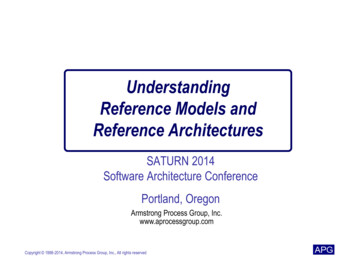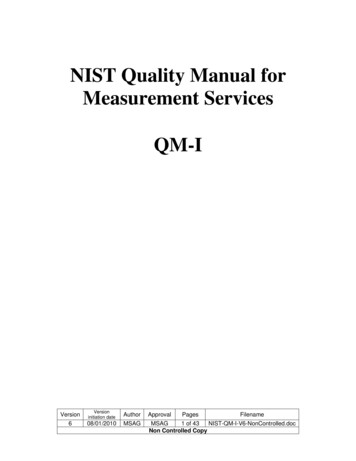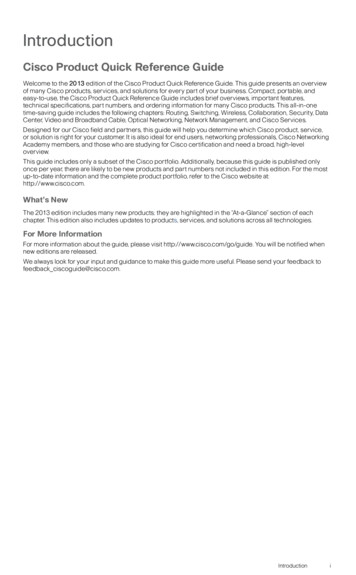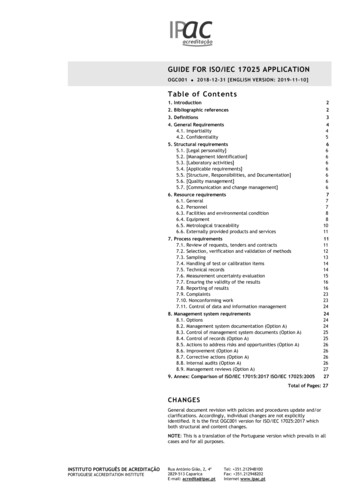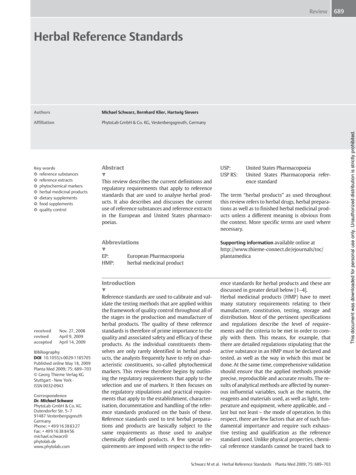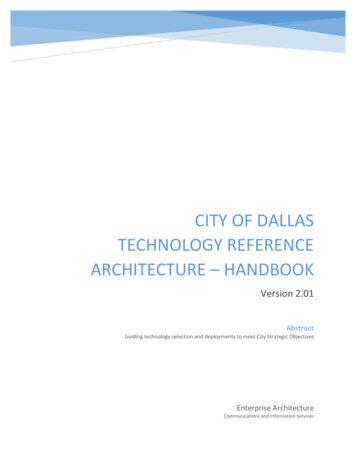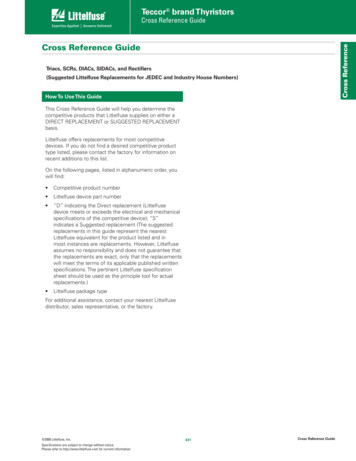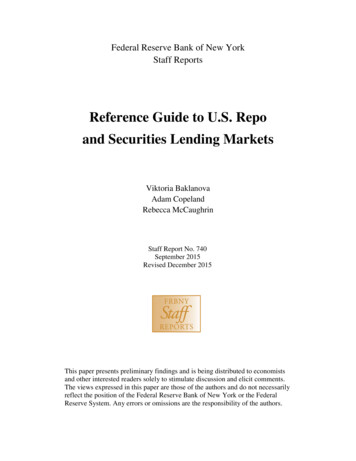
Transcription
Federal Reserve Bank of New YorkStaff ReportsReference Guide to U.S. Repoand Securities Lending MarketsViktoria BaklanovaAdam CopelandRebecca McCaughrinStaff Report No. 740September 2015Revised December 2015This paper presents preliminary findings and is being distributed to economistsand other interested readers solely to stimulate discussion and elicit comments.The views expressed in this paper are those of the authors and do not necessarilyreflect the position of the Federal Reserve Bank of New York or the FederalReserve System. Any errors or omissions are the responsibility of the authors.
Reference Guide to U.S. Repo and Securities Lending MarketsViktoria Baklanova, Adam Copeland, and Rebecca McCaughrinFederal Reserve Bank of New York Staff Reports, no. 740September 2015; revised December 2015JEL classification: G10, G18, L10AbstractThis paper is intended to serve as a reference guide on U.S. repo and securities lending markets. Itbegins by presenting the institutional structure, and then describes the market landscape, the roleof the participants, and other characteristics, including how repo and securities lending activityhas changed since the 2007-09 financial crisis. The paper then discusses vulnerabilities in therepo and short-term wholesale funding markets and the efforts to limit potential systemic risks. Itnext provides an overview of existing data sources on securities financing markets and highlightsspecific shortcomings related to data standards and data quality. Lastly, the authors discuss anear-term agenda to help fill some of the data gaps in repo and securities lending markets.Key words: repo, securities lendingBaklanova, McCaughrin: Office of Financial Research, U.S. Department of the Treasury (e-mail:viktoria.baklanova@treasury.gov, rebecca.mccaughrin@treasury.gov). Copeland: FederalReserve Bank of New York (e-mail: adam.copeland@ny.frb.org). The authors thank CeciliaCaglio, Jill Cetina, Gregory Feldberg, Frank Keane, Jeffrey Kidwell, Antoine Martin, SusanMcLaughlin, Zoltan Pozsar, Mark Roe, Susan Stiehm, Stathis Tompaidis, David Weisbrod, JohnZitko, and other reviewers (who wished to remain anonymous) for constructive comments onearlier versions of this paper. They also thank Dagmar Chiella, Arthur Fliegelman, and BrookHerlach for their research contributions, Andrew Morehead for data management support, andMichelle Farrell for her guidance on design. The views expressed in this paper are those of theauthors and do not necessarily reflect the position of the Office of Financial Research at the U.S.Department of the Treasury, the Federal Reserve Bank of New York, or the Federal ReserveSystem.
Table of Contents12Introduction . 1Market Overview . 22.1Repo Activity . 42.1.1 Role and basic mechanics . 42.1.2 Market size . 102.1.3 Main participants and their motivations . 152.1.4 Key attributes . 182.1.5 Legal arrangements . 202.2 Securities Lending Activity. 2132.2.1 Role and basic mechanics . 212.2.2 Market size . 232.2.3 Main participants and their motivations . 262.2.4 Key attributes . 302.2.5 Legal arrangements . 32Vulnerabilities . 333.1Repo market . 333.1.1 Regulatory efforts targeting leverage and liquidity risk. 343.1.2 Repo market infrastructure . 373.1.3 Risk of fire sales . 383.2 Securities lending activities . 4043.2.1 Indemnification . 413.2.2 Collateral management . 42Overview of Data Coverage and Gaps . 464.1Repo market . 464.1.1 Data collections based on reporting entity type . 464.1.2 Market-specific data collection . 524.2 Securities lending activities . 544.2.1 Data collections based on reporting entity type . 544.2.2 Market specific data collections . 574.3 Financial Accounts of the United States Report . 594.4 Data quality, gaps, and overlaps. 5956Conclusion . 60Bibliography . 62
1 IntroductionThis reference guide focuses on the market microstructure, vulnerabilities, and data gapsin the U.S. securities financing markets, where firms transact using repurchase agreements (repo)or securities lending contracts. Repos allow one firm to sell a security to another firm with asimultaneous promise to buy the security back at a later date at a specified price. The economiceffect of this transaction is similar to that of a collateralized loan. Securities lending involves ashort-term loan of stocks or bonds in exchange for cash or noncash collateral. The economiceffect of this transaction can be similar to that of a repo especially in cases when a securitieslending transaction is collateralized by cash. Under current U.S. market practice, repos aremainly used to borrow cash using securities as collateral. Securities lending contracts are mainlyused to access collateral securities using cash as collateral. Such transactions enable firms toestablish short positions, hedge, and facilitate market-making activity.The importance of repo and securities lending in the U.S. financial markets is evidencedby their prevalent use. Although daily volumes in the repo market have declined since the crisis,they still dwarf the amount transacted in unsecured cash markets. Due to a lack of data, there is awide range of estimates of total repo and securities lending activity. For example, total repoactivity at its peak level before the 2007-09 financial crisis ranged from 5 to 10 trillion. 1 In thecurrent post-crisis era, our estimate of total repo activity is around 5 trillion and our estimate ofthe outstanding value of securities on loan is just under 2 trillion. Both repo and securitieslending markets came under pressure during the 2007-09 financial crisis. Gorton and Metrick(2012) and Copeland, Martin, and Walker (2014) describe different mechanisms through whichruns occur in repo markets, and Krishnamurthy, Nigel, and Orlov (2014) emphasize the role ofcollateral in propagating a run. In addition, Keane (2013) discusses the risks associated withsecurities lending and advocates for greater regulatory and market scrutiny of this activity.1Market size estimates vary partly due to different time periods and estimation techniques. Copeland, et al.(2012) estimate the outstanding value of repo and reverse repo activity at 3 trillion and 2 trillion, respectively,whereas Gordon and Metrick (2012) and Singh and Aitken (2010) estimate total repo activity is around 10 trillion.Incidences of double-counting may inflate some of the higher estimates.1
Coming out of the financial crisis, regulators have focused on reforming practices in both repoand securities lending markets. 2A clear understanding of the institutional structure of the U.S. securities financingmarkets and their vulnerabilities is a necessary step for making good policy. In Section 2, wereview the basic mechanics of repo and securities lending activity, and describe the main users ofthese contracts and their motivations. This section also highlights the central role that securitiesdealers play in both markets, where, alongside their own trading activity, they also act asintermediaries (see also Pozsar, 2014). In Section 3, we describe the main vulnerabilities of repoand securities lending. We discuss ongoing efforts to improve the robustness of the settlementprocess for repo contracts and highlight outstanding risks. Further, we discuss risks specific tosecurities lending, such as the common practice of indemnification, where the agent facilitating asecurities lending transaction may offer certain guarantees to the securities owner. In Section 4,we describe data sources on repo and securities lending activity available to regulators and thepublic. We highlight specific gaps related to data coverage and data quality. While fairlycomprehensive and granular data are available for the triparty repo market and the GeneralCollateral Financing Repo (GCF Repo ) Service, data available on bilateral repo and securitieslending transactions are spotty and incomplete. 3 Finally, in Section 5, we conclude by proposinga near-term agenda to assist with filling some of the data gaps in repo and securities lendingactivities.2 Market OverviewThis section provides an overview of how U.S. repo and securities lending marketsfunction. Securities dealers have historically been central to both activities as intermediaries.Figure 1 shows a stylized balance sheet of a traditional securities dealer that intermediates the2See the Financial Stability Oversight Council annual reports. International efforts are also under way. Forexample, the Financial Stability Board (FSB) is taking steps to address weaknesses in repo and securities lendingmarkets. See the FSB, “Strengthening Oversight and Regulation of Shadow Banking: Policy Framework forAddressing Shadow Banking Risks in Securities Lending and Repos,” August 29, 2013, t/uploads/r 130829b.pdf?page moved 1.3GCF Repo Service (GCF Repo) is a registered FICC service mark.2
flow of cash and collateral in the market. Securities enter the dealer’s balance sheet on the assetside and leave on the liability side, and cash moves in the opposite direction, entering on theliability side and leaving on the asset side (see Figure 1, line 1). Security and cash movementsare generated by either a motivation to raise/lend cash (via repos/reverse repos, see Figure 1, line2), or a motivation to borrow/lend securities (via securities borrowing/lending transactions, seeFigure 1, line 3). 4 The net effect of these flows are inventories, which result in either long orshort positions in securities, or equivalently, short or long positions in cash. The “repledge”labels in Figure 1 highlight that securities received as collateral from repo and securities lendingcontracts can be repledged (or reused) to settle reverse repo and securities borrowing contracts.Figure 1 also highlights the economic similarities between repo and securities lendingcontracts. To minimize their own funding costs, securities dealers raise cash wherever it is thecheapest and lend cash at the highest rate within established risk management limits. Dealersalso obtain collateral wherever it is the cheapest and repledge collateral wherever it is the mostvaluable. Once cash and collateral are in the hands of a dealer, the method the dealer uses toacquire the cash or collateral has limited relevance.4From the perspective of a dealer, repos are trades in which the dealer has promised to deliver securitiesagainst cash, whereas reverse repos are trades in which the dealer has promised to deliver cash against securities.Similarly, securities lending are trades in which the dealer has promised to deliver securities in exchange for cash ornoncash collateral, and securities borrowing are trades where the dealer receives securities and delivers cash or noncash collateral.3
Figure 1: Cash and Securities Flow through the Balance Sheet of a Securities DealerNote: Securities received as collateral from repo and securities lending contracts can be repledged (or reused) tosettle reverse repo and securities borrowing contracts.Source: OFR analysis2.1 Repo Activity2.1.1 Role and basic mechanicsA repo contract is economically equivalent to an interest-bearing cash loan againstsecurities collateral. The difference between the sale and repurchase price of securities specifiedin a repo contract is reflected in the implied interest rate. For example, if a firm agrees to sell 9million in Treasuries today and repurchase those same Treasuries for 9.09 million in a year, theimplied interest rate is 1 percent. The securities are used as collateral to protect the cash investoragainst the risk that the collateral provider is unable to repurchase the securities at the later date(the repurchase date), as initially agreed. The cash investor typically demands that the marketvalue of collateral exceeds the value of the loan. The amount by which the loan is overcollateralized is called a haircut (for a discussion on haircuts see Section 2.1.4).Repo contracts can also be used to borrow securities. In this case, the collateral providerearns a return by investing the cash it receives from the cash investor at a higher rate than that4
implied by the repo contract. For example, the collateral provider may negotiate a repo to pay animplied interest rate of 1 percent, with the knowledge that he can reinvest the received cash in amoney market instrument and earn 2 percent. The cash investor is willing to earn a below-marketrate on his cash, because the securities posted as collateral are “special,” meaning they have anintrinsic value which the cash investor will attempt to monetize (Duffie, 1996).The repo market has a long history and has gone through a number of institutionalchanges. Repo financing has been used by Federal Reserve banks to provide credit to memberbanks since 1917 (Beckhart, Smith and Brown 1932). During the 1920s, the Federal ReserveBank of New York used repos with securities dealers unaffiliated with a bank to encourage thedevelopment of a liquid secondary market for banker’s acceptance notes (Garbade, 2006). Withthe passage of the Treasury-Federal Reserve Accord of 1951, the interdealer repo market beganto develop.The U.S. repo market is comprised of two segments, based on differences in settlement:triparty repo and bilateral repo. A triparty repo involves a third party, which is a clearing bank.The clearing bank provides back-office support to both parties in the trade, by settling the repoon its books and ensuring that the details of the repo agreement are met. In the U.S., triparty reposervices are currently offered by Bank of New York Mellon Corp. (BNY Mellon) and JPMorganChase & Co. (JPMorgan), both of which provide clearing and settlement services to securitiesdealers. In contrast, in a bilateral repo, each counterparty’s custodian bank is responsible for theclearing and settlement of the trade.There are four main distinctions between bilateral and triparty repos: timing of settlement, settlement risk protections, cost of clearing and settlement, and the ability to specify that any security within a general asset class can serve ascollateral.5
First, with respect to the timing of settlement, a collateral provider in a bilateral repousually delivers its securities, or agrees which specific security will be delivered, by 11 a.m.(Fleming and Garbade, 2003). 5 In triparty repo, collateral providers tend to finalize theirsecurities allocation decision later in the day. Second, securities posted as collateral for a tripartyrepo cannot be repledged outside the triparty platform. This design feature protects the collateralproviders against settlement fails on the closing leg of the repo. In the case of bilateral repo, thecash investor receives full control over movement and use of the securities posted as collateral,exposing the collateral provider to the possibility of a settlement failure on the closing leg of therepo. Third, triparty repo leverages the technology of the clearing banks to handle and value awide variety of securities, which may enhance operational efficiency for customers depending ontheir size and sophistication. Clearing and settling bilateral repos, in contrast, is handled by thetrading counterparties and entails higher operational costs. Fourth, triparty repo typicallyassumes a transaction involving “general collateral,” where the cash investor agrees to acceptany securities within an asset class, such as U.S. Treasuries. Bilateral repos, by contrast, typicallyrequire that specific securities identified at the CUSIP level be agreed upon when the trade isexecuted.2.1.1.1 Bilateral repoWhen negotiating a bilateral repo, two parties agree on the terms of trade, including theprincipal amount of the repo, the interest rate paid by the collateral provider, the type ofsecurities to be delivered, the haircut to be applied for the collateral pledged, and the maturity ofthe repo. 6 See Figure 2 for a schematic of a bilateral repo. In the opening leg of a repo, thecollateral provider delivers securities to the cash investor in exchange for cash. In the closing leg,these flows are reversed; the cash investor returns the securities to the collateral provider inexchange for cash.5This describes a generic practice. However, a number of market participants employ proprietary repotrading systems that allow the dealer to transmit the collateral information later in a day.6The interest rate in repo agreements is inferred from the price differential between the sale price ofsecurities and the repurchase price.6
There are two main motivations for transacting in the bilateral repo market instead oftriparty. First, securities dealers prefer to rely on bilateral repo to acquire securities. Both theability to repledge and the earlier settlement timing favor the use of bilateral repo. The tripartyrepo platform is designed to support general collateral repo trades, which are used to securefunding. Second, securities dealers rely on bilateral repo as a way of providing funding to theirclients. Dealers typically run matched books, taking both sides of a trade and serving as anintermediary between their clients and large cash pool investors. For example, dealers mayprovide funding to mortgage real estate investment trusts (mREITs) using bilateral repocontracts, where the mREIT posts mortgage-backed securities (MBS) as collateral. In thiscontext, the advantages of a bilateral repo are the dealer’s control of the securities posted ascollateral and the timing of settlement, both of which enable the dealer to repledge the collateralin order to earn a return on another trade.Figure 2: Example of a Bilateral RepoNote: The haircut is equal to one minus the ratio of the cash invested over the value of the collateral received.Source: Authors’ analysis7
2.1.1.2 Triparty repoTriparty repo contracts settle on the books of the clearing bank, where cash and securitiesare moved between the cash investor’s and collateral provider’s respective accounts. Theclearing bank does not take on the role of principal, but rather acts as an agent, ensuring that theterms of the repo contact are upheld. 7 Clearing banks effectively perform back-office operationsfor both securities dealers and cash investors and, due to their efficiency, have become animportant platform used by securities dealers for short-term funding. Relative to bilateral repo,triparty repo appeals to securities dealers because trades are settled later in the day, allowingdealers to access funding for securities acquired in the early afternoon.The triparty repo service provides protection to both parties. Cash investors protectthemselves from a dealer default by negotiating a haircut, which requires the dealer to overcollateralize the repos. Collateral providers are protected from settlement fails, because thesecurities they post as collateral remain in the custody of the clearing bank and cannot be reusedoutside the clearing banks’ triparty repo settlement platform. Lastly, triparty repo offers greaterflexibility in collateral management. For example, smaller and less liquid pieces of collateral canbe posted. Clearing banks have developed technology to optimize their use of collateral(Copeland, et al., 2012). Collateral securities can easily be substituted to provide dealers with thecheapest funding option, while still meeting investors’ collateral guidelines.GCF Repo, introduced in 1998 by the Fixed Income Clearing Corporation (FICC), alsosettles on the triparty platform. GCF Repo is designed for FICC’s netting members (securitiesdealers) to trade cash and securities among themselves based on negotiated rates and terms.87Before the Federal Reserve Bank of New York’s triparty repo infrastructure reforms took place, theclearing banks did take on the role of principal during the business day. Significant progress has been made toreduce the principal role of the clearing banks although they still act in this capacity for a small segment of thetriparty repo market. For information on the reforms, see http://www.newyorkfed.org/banking/tpr infr reform.html.Clearing banks also act as securities intermediaries for both counterparties, transferring security entitlements to thecollateral to and from the seller and buyer.8Currently, securities dealers account for the vast majority of GCF Repo activity. FICC seeks to expand thetypes of financial institutions allowed to participate to include insured credit unions (see SEC filing 34-73391) andregistered investment companies (see SEC filing 34-71265).8
GCF Repo trades are completed on an anonymous basis through interdealer brokers. 9 FICC actsas a central counterparty in GCF Repo, interposing itself and serving as the legal counterparty toeach side of the repo transaction for settlement purposes. FICC also provides a netting service,allowing dealers to offset their repo and reverse repo positions for trades where the securitiesposted as collateral are of a similar type.In Figure 3, we present an example of a GCF Repo trade, with terms similar to thebilateral repo example presented in Figure 2. A distinguishing feature of GCF Repo is the role ofFICC as the central counterparty. In a GCF Repo contract, the haircut is zero percent. As a riskmanagement precaution, the FICC sets eligibility thresholds for GCF Repo participants, collectsmargin, and requires that institutions post collateral to a clearing fund.GCF Repo is designed as a general collateral repo, where FICC defines the set ofpermissible collateral classes, including Treasuries, and Fannie Mae and Freddie Mac fixed ratemortgage-backed securities (MBS). 10 Dealers rely on GCF Repo contracts for a variety offunctions, including raising funds and seeking collateral to fulfill triparty repo obligations(Agueci, et al. 2014).GCF Repos are settled on the books of BNY Mellon and JPMorgan using the tripartyrepo settlement platform. The settlement process allows for a tight connection between GCFRepo and triparty repo. Both types of trades are settled on the transaction day and, importantly,GCF Repo is settled before triparty repo. This enables dealers to repledge securities obtained ascollateral in GCF Repo into triparty repo. A detailed overview of the GCF Repo settlementprocedure is provided in Agueci et al. (2014).9Interdealer brokers are specialized securities companies that act as middlemen in nearly every type ofsecurities market to effect transactions among dealers who trade as principals in these markets. See the rg/news/news.aspx?id 3936.10At present, nine generic securities types are eligible for the GCF Repo Service. Seehttp://www.dtcc.com/ CF%20Collateral%20Eligibility%20Jan%202014.ashx.9
Figure 3: Schematic of a GCF Repo TradeSource: Authors’ analysis2.1.2 Market sizeIn this section, we provide a rough estimate of the total size of the U.S. repo market andits various segments. Insufficient data on the bilateral segment of the repo market precludes usfrom offering a more precise analysis. Section 4 discusses data gaps in more detail. In Section 5,we outline the ongoing efforts to fill these data gaps.10
The Federal Reserve’s Form FR 2004, also known as the Government Securities DealersReports, is the main source of information on U.S. primary dealer market-making activity. 11 Thisform includes total repo and reverse repo activity, by collateral class and maturity (Section 4.1has further details of this dataset). The total amount of repo that primary dealers enter into issubstantial, almost 2.2 trillion in repo and just under 2 trillion in reverse repo.A repo trade between primary dealers shows up twice in the Form FR 2004 data, once asa repo and then again as a reverse repo, representing both legs of the trade. Thus, summing upthe repo and reverse repo numbers would result in double-counting and inflate total activity inthe U.S. repo market. Unfortunately, the size of the interdealer market is not known and,therefore, the extent of the double-counting cannot be determined. As a result, we measure repoand reverse repo activity separately.Form FR 2004 data only cover activities of primary dealers. Therefore, any estimatebased on that data is likely to underestimate the total size of the repo market. Discussions withmarket participants suggest that the nonprimary dealer’s market share is smaller than thatattributed to the primary dealers, but growing.Monthly triparty repo and GCF Repo data published by the Federal Reserve Bank of NewYork show triparty repo trades are mostly collateralized by U.S. Treasuries and agency MBS(see Using the triparty repo, GCF Repo, and Form FR 2004 data, we arrive at rough estimates ofthe size of each repo segment. Because they come from different sources and cover differentsamples, we make a few adjustments. First, as detailed in Copeland et al. (2014), we scale up theForm FR 2004 repo number to account for non-primary dealer activity, assuming that primarydealers represent 80 percent of total triparty repo activity. Then, we deflate total triparty repovolumes to remove the value of collateral posted to satisfy haircut requirements. The timing of11As of August 2015, 22 institutions were designated as primary dealers: Bank of Nova Scotia, New YorkAgency, BMO Capital Markets Corp., BNP Paribas Securities Corp., Barclays Capital Inc., Cantor Fitzgerald & Co.,Citigroup Global Markets Inc., Credit Suisse Securities (USA) LLC, Daiwa Capital Markets America Inc., DeutscheBank Securities Inc., Goldman, Sachs & Co., HSBC Securities (USA) Inc., Jefferies LLC, J.P. Morgan SecuritiesLLC, Merrill Lynch, Pierce, Fenner & Smith Incorporated, Mizuho Securities USA Inc., Morgan Stanley & Co.LLC, Nomura Securities International, Inc., RBC Capital Markets, LLC, RBS Securities Inc., SG AmericasSecurities, LLC, TD Securities (USA) LLC, and UBS Securities LLC.11
the data released across the data sources does not match up precisely, but no adjustment is madesince the difference in timing is usually no more than one or two days.Figure 5). 12 Similarly, GCF Repo trades are mostly collateralized by U.S. Treasuries andagency MBS.Figure 4: Total Primary Dealer Repo and Reverse Repo Activity ( trillion)Primary dealers mainly transact in repos and reverse repos collateralized by U.S. Treasury andagency MBS securities1.61.4Total repo: 2.2 trillionTotal reverse repo: 1.8 trillion1.21.00.80.60.40.20.0AgencyAgency Corporate EquitiesU.S.OtherMBSTreasuries& TIPSNote: Agency represents all non-MBS issued by federal agencies or government-sponsored enterprises. AgencyMBS are all MBS issued by federal agencies or government-sponsored enterprises. Corporate is corporate debt,including commercial paper. TIPS is Treasury Inflation-Protected Securities.Source: Federal Reserve Form FR 2004, June 2015Using the triparty repo, GCF Repo, and Form FR 2004 data, we arrive at rough estimatesof the size of each repo segment. Because they come from different sources and cover differentsamples, we make a few adjustments. First, as detailed in Copeland et al. (2014), we scale up theForm FR 2004 repo number to account for non-primary dealer activity, assuming that primarydealers represent 8
September 2015; revised December 2015 JEL classification: G10, G18, L10 Abstract This paper is intended to serve as a reference guide on U.S. repo and securities lending markets. It begins by presenting the institutional str

